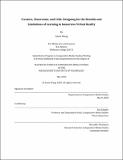| dc.contributor.advisor | Eric Klopfer. | en_US |
| dc.contributor.author | Wang, Annie | en_US |
| dc.contributor.other | Massachusetts Institute of Technology. Department of Comparative Media Studies. | en_US |
| dc.date.accessioned | 2020-09-21T16:42:08Z | |
| dc.date.available | 2020-09-21T16:42:08Z | |
| dc.date.copyright | 2020 | en_US |
| dc.date.issued | 2020 | en_US |
| dc.identifier.uri | https://hdl.handle.net/1721.1/127661 | |
| dc.description | Thesis: S.M. in Comparative Media Studies, Massachusetts Institute of Technology, Department of Comparative Media Studies/Writing, May, 2020 | en_US |
| dc.description | Cataloged from the official PDF of thesis. | en_US |
| dc.description | Includes bibliographical references (pages 91-100). | en_US |
| dc.description.abstract | In the last few years, the perception of virtual reality (VR) has shifted from an entertaining novelty to an increasingly mainstream technological medium. However, the methods of creating and assessing high-fidelity immersive VR for learning remain nascent. With the growing demands for change in the 21st-century American education system, it is increasingly important for designers and developers to approach the topic of VR for K-12 learning thoughtfully yet critically. This thesis grounds VR within the greater context of technology-mediated learning by examining its affordances, relevant educational frameworks, and cognitive limitations through the academic lenses of pedagogy, cognitive science, and educational psychology. It then utilizes a case study, the CLEVR project, to trace an in-depth example of an ongoing VR game through user feedback, data analysis, and iterative game design. Ultimately, I use findings generated from the CLEVR project to develop recommendations for designing and integrating VR into K-12 classrooms, with the hopes of informing current and future designers about balancing VR's affordances with learning outcomes in order to develop successful immersive learning experiences. | en_US |
| dc.description.statementofresponsibility | by Annie Wang. | en_US |
| dc.format.extent | 152 pages | en_US |
| dc.language.iso | eng | en_US |
| dc.publisher | Massachusetts Institute of Technology | en_US |
| dc.rights | MIT theses may be protected by copyright. Please reuse MIT thesis content according to the MIT Libraries Permissions Policy, which is available through the URL provided. | en_US |
| dc.rights.uri | http://dspace.mit.edu/handle/1721.1/7582 | en_US |
| dc.subject | Comparative Media Studies. | en_US |
| dc.title | Creators, classrooms, and cells : designing for the benefits and limitations of learning in immersive virtual reality | en_US |
| dc.type | Thesis | en_US |
| dc.description.degree | S.M. in Comparative Media Studies | en_US |
| dc.contributor.department | Massachusetts Institute of Technology. Program in Comparative Media Studies/Writing | |
| dc.identifier.oclc | 1192966594 | en_US |
| dc.description.collection | S.M.inComparativeMediaStudies Massachusetts Institute of Technology, Department of Comparative Media Studies/Writing | en_US |
| dspace.imported | 2020-09-21T16:42:07Z | en_US |
| mit.thesis.degree | Master | en_US |
| mit.thesis.department | CMS | en_US |
